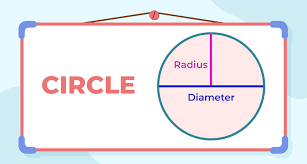To find the radius of a circle, measure from the center to the edge. Use the formula C = 2πr to find the circumference. For the area, use A = πr^2. Trigonometry helps relate the radius to other circle properties. Practice with examples to master these methods. By understanding the radius, you can tackle real-world problems and explore geometric principles further.
The Basics of Circle Radius
Understanding the radius of a circle is essential for various mathematical calculations and geometric applications. The radius is the distance from the center of a circle to any point on its circumference. To find the radius, you can measure the distance from the center to any point on the circle’s edge. This measurement remains constant regardless of where you choose to measure it on the circle.
In geometry, the radius is a fundamental component when calculating the area and circumference of a circle. It’s also crucial in determining the diameter, which is twice the length of the radius. When working with circles, knowing the radius allows you to make precise calculations and solve problems efficiently.
Additionally, the radius plays a significant role in various real-world applications, such as engineering, architecture, and physics. Whether you’re designing a bridge, calculating the area of a circular garden, or analyzing planetary orbits, a solid grasp of the radius is indispensable. By understanding the basics of circle radius, you pave the way for mastering more complex geometric concepts and practical problems.
Using the Circumference Formula
To calculate the circumference of a circle, you can use the formula C = 2πr, where C represents the circumference and r is the radius. This formula shows that the circumference is equal to two times π times the radius.
By plugging in the value of the radius into this formula, you can find the circumference of the circle. For example, if the radius of a circle is 5 units, you’d calculate the circumference by substituting r = 5 into the formula: C = 2π(5) = 10π units. This means the circumference of the circle with a radius of 5 units is 10π units.
Using the circumference formula is a straightforward way to find the distance around a circle based on its radius. It’s an essential formula in geometry and is often used in various math and real-world applications.
Applying the Area Formula
When calculating the area of a circle, you can use the formula A = πr^2, where A represents the area and r is the radius. This formula is derived from the fact that the area of a circle is proportional to the square of its radius. By squaring the radius and multiplying it by the constant π (pi), you can find the total space enclosed by the circle.
To apply the area formula, simply substitute the given radius into the equation. For example, if the radius of a circle is 5 units, you’d calculate the area as A = π(5)^2 = 25π square units. Remember to include the units squared since area is a two-dimensional measurement.
Using the area formula is essential in various real-world applications, such as calculating the space within a circular garden, determining the amount of material needed for a circular tablecloth, or estimating the capacity of a circular swimming pool. Mastering this formula will enable you to solve a wide range of problems involving circles efficiently.
Utilizing Trigonometry for Radius
Calculating the radius of circles can be effectively achieved by utilizing trigonometry to determine the relationship between the radius and other geometric properties. When dealing with circles, trigonometry comes in handy to find the radius when other parameters are known. By using trigonometric functions such as sine, cosine, and tangent, you can establish connections between the radius, the circle’s diameter, and angles within the circle.
One commonly used method is to consider a right triangle inscribed in a circle. By drawing a radius to one of the points of tangency, you create a right angle. This allows you to apply trigonometric ratios to relate the radius to the other sides of the triangle. For instance, the sine of an angle in the triangle can help you find the radius if the angle and another side length are known.
Practical Examples and Exercises
In practical applications, understanding how to apply trigonometry to determine circle radii can be honed through engaging in various exercises. By working through practical examples, you can solidify your grasp on calculating circle radii accurately.
For instance, consider a scenario where you need to find the radius of a circular garden. You can measure the garden’s circumference and then use the formula ( r = rac{C}{2\pi} ) to determine the radius.
Another exercise could involve calculating the radius of a pulley system essential in engineering. By applying trigonometric functions such as sine and cosine to the angles involved, you can easily compute the radius of the pulley.
These exercises not only sharpen your trigonometry skills but also demonstrate the real-world applications of finding circle radii. So, grab a pen, solve some circle radius problems, and witness firsthand how trigonometry can unveil the mysteries of circles around you.
Frequently Asked Questions
Can the Radius of a Circle Be Negative?
Yes, the radius of a circle cannot be negative since it represents the distance from the center to any point on the circle. It is always a positive value, as it measures a length.
What Is the Significance of the Radius in Relation to Other Circle Measurements?
Understanding the significance of the radius is crucial in geometry. It’s half the diameter and helps determine the circle’s area and circumference. Knowing the radius lets you calculate various properties of circles accurately, enhancing your mathematical skills.
Is There a Limit to How Large or Small a Circle’s Radius Can Be?
There’s no strict limit to a circle’s radius size, but practically, it’s constrained by factors like available space or the precision of your tools. A circle’s radius can be as big or small as needed.
How Does the Radius of a Circle Affect Its Overall Shape and Properties?
When you adjust a circle’s radius, its size and properties change. A larger radius increases the circle’s area and circumference. The radius directly impacts the circle’s curvature and how it interacts with other shapes in geometric calculations and designs.
Are There Any Real-Life Applications Where Knowing the Radius of a Circle Is Crucial?
In real life, knowing a circle’s radius is crucial in fields like engineering, architecture, and physics. Whether designing a bridge or calculating planetary orbits, understanding the radius helps determine dimensions, forces, and trajectories accurately.
Conclusion
So there you have it – finding the radius of a circle isn’t as difficult as it may seem. By using formulas like the circumference formula, area formula, and even some trigonometry, you can easily calculate the radius of any circle.
Practice with some examples and exercises to solidify your understanding. With these methods in your toolkit, you’ll be a radius-finding pro in no time!


